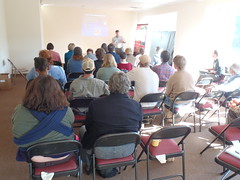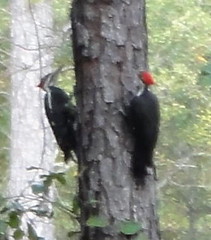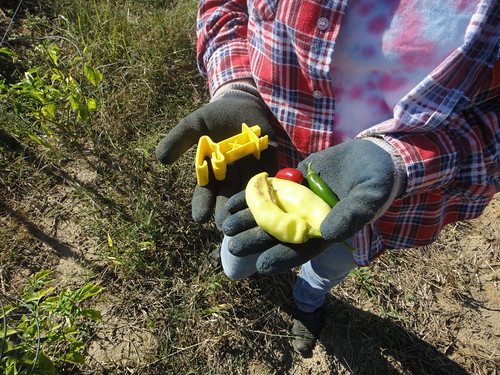
Beautyberry (Callicarpa americana) at Okra Paradise Farms
by John S. Quarterman, Lowndes County, Georgia, 4 June 2008.
Growing along the stems of a green-smelling bush: Continue reading

Beautyberry (Callicarpa americana) at Okra Paradise Farms
by John S. Quarterman, Lowndes County, Georgia, 4 June 2008.
Growing along the stems of a green-smelling bush: Continue reading
 realized nobody else was going to hold a conference
about growing local in the characteristic soils and climate
and with the characteristic foods and culture of
south Georgia, so
okravores met in Tifton
and learned about everything from controling insect to which breeds of cows
produce the best organic milk.
Raven demonstrated
you can make cheese in south Georgia
and Gretchen
demonstrated preserving beautyberry and other jams and jellies,
along with many other interesting talks and demonstrations, and good food.
The South Georgia Growing Local Conference is back,
this time near Reidsville, in January.
realized nobody else was going to hold a conference
about growing local in the characteristic soils and climate
and with the characteristic foods and culture of
south Georgia, so
okravores met in Tifton
and learned about everything from controling insect to which breeds of cows
produce the best organic milk.
Raven demonstrated
you can make cheese in south Georgia
and Gretchen
demonstrated preserving beautyberry and other jams and jellies,
along with many other interesting talks and demonstrations, and good food.
The South Georgia Growing Local Conference is back,
this time near Reidsville, in January.
When:
Saturday, Jan. 14, 2012, 9-5
UGA’s Vidalia Onion & Vegetable Research Center, between Lyons & Reidsville, Ga. & Red Earth Farm, ReidsvilleWhat: Continue reading
Broccoli and gardener: Continue reading
And a video:
Rain at Okra Paradise Farms, Lowndes County, Georgia.
Picture and video by Gretchen Quarterman, 16 November 2011.
-jsq
Gretchen Quarterman takes a break and joins them. Continue reading
 They’re almost big enough.
They’re almost big enough.
Or maybe a pair of Southern Pileated Woodpeckers (Dryocopus pileatus) on a longleaf pine (Pinus Palustris).
I got pretty close; they just laughed. Eventually I walked away to do something else, and they flew into another tree directly over my head, where you see them in this video:
Pileated Woodpeckers, Dryocopus pileatus, Lowndes County, Georgia.
Pictures by John S. Quarterman, 7 November 2011.
-jsq
 Aunt Elsie gets mentioned again for her pioneering career in plant ecology.
Aunt Elsie gets mentioned again for her pioneering career in plant ecology.
According to the Nature Conservancy (undated), Tennessee Coneflower — No Longer Endangered
After years of hard work and the support of many dedicated individuals, an iconic flower is once again thriving in Tennessee. On August 4, 2011, the U.S. Fish and Wildlife Service announced the removal of the Tennessee coneflower from the Endangered Species List, marking an extraordinary recovery from the brink of extinction. The story of the coneflower exemplifies the power of conservation.Her nephew Patrick found this.In 1968, Vanderbilt biology professor Elsie Quarterman and graduate student Barbara Turner accidentally discovered the fuschia-colored coneflowers at Mount View Cedar Glade. The plant had been thought extinct until the rediscovery. In time, three other coneflower sites were discovered in Davidson and Wilson counties. In 1979, the Tennessee coneflower became one of the first plants to be recorded on the Endangered Species List.
Quarterman subsequently became a trustee of the Tennesee Chapter of The Nature Conservancy and urged the protection of the cedar glade habitats where the Tennessee coneflower and other rare plants have adapted to live in harsh, stony conditions.
-jsq
Something about circular furrows in a rectangular field….
Will these grow crop circles? Continue reading

Picture by John S. Quarterman, Lowndes County, Georgia, 6 October 2011.
Those are pepper plants to Gretchen’s right, if that helps. Continue reading